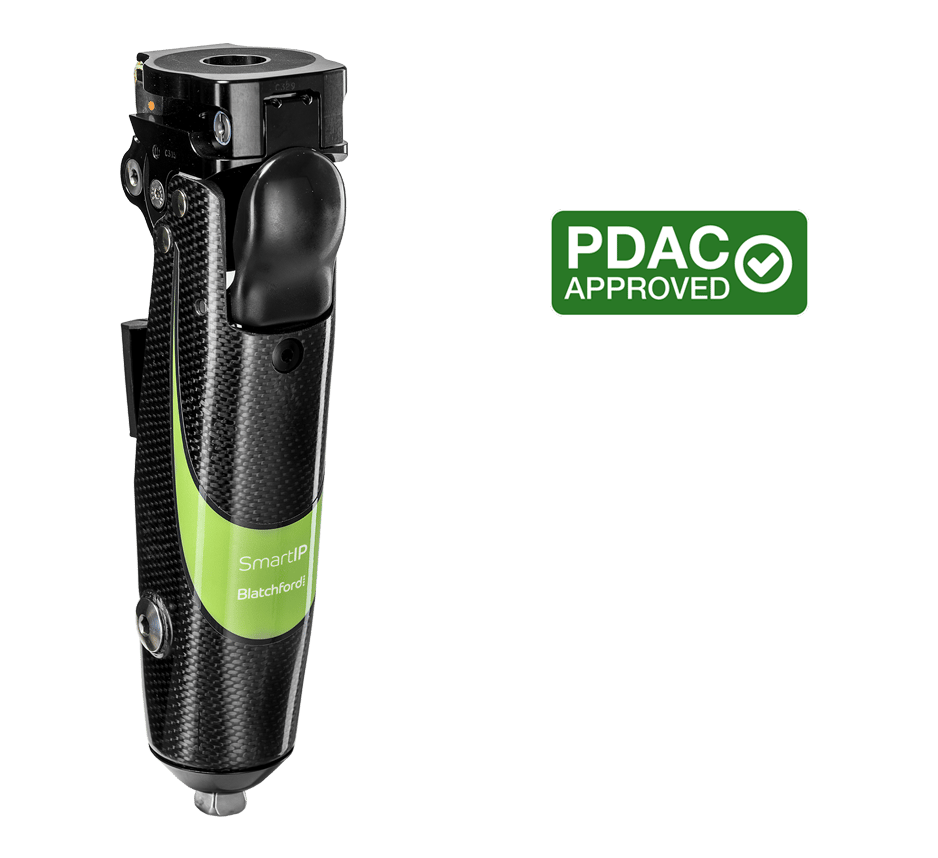SmartIP
The SmartIP microprocessor controlled knee employs intelligent programming technology that dynamically programs the knee to optimum swing settings for the individual Level 2-3-(4) activity user, reducing the amount of energy expended by trans-femoral prosthesis users. The weight activated stance control provides an adjustable smooth and yielding transition at toe off.
SmartIP’s intelligent program technology taps into the body’s ability to self-optimize during calibration; enabling the device to select appropriate resistances for the user to adjust seamlessly between very slow and fast walking speeds as they navigate daily pursuits. Blatchford’s stabilized knee mechanism combined with microprocessor swing phase control gives the confidence of proven mechanical security whilst reducing the amount of energy required for transfemoral users to engage in level 2-3 activities more comfortably throughout the day.
Characteristics:
- Microprocessor control of swing phase allows variable cadence over a wide range of walking speeds.
- Microprocessor control taps into the body’s ability to self-optimize and walk in the most energy efficient way.
- Confidence to walk over uneven outdoor surfaces including slopes due to smooth activation and release of the user customized stabilizing knee mechanism.
- Battery life expectancy 9-12 months under normal use, but frequently lasts up to 18 months.
- A comfortable user-initiated gait, from very slow to fast walking.
- Faster progress with simple programming.
- Weight-activated stance control. Braking set/customized to the individual’s requirements- smooth activation and release.
- Stanceflex option offers shock absorption at heel strike, improves comfort, and provides a more natural gait.
- 4-bolt option reduces build height and readily interfaces to multiple connection options.
- 140° knee flexion.
- Independently verified reduced energy costs compared to devices with fixed damping.
SmartIP Clinical Evidence Reference
Improvements in Clinical Outcomes using prosthetic knees with microprocessor-controlled swing phase
-
Safety
- Less cognitive demand during walking, leading to reduced postural sway1
-
Mobility
- Increased walking speed2-5
- Easier to walk at different speeds4,6
- More natural gait4
- Easier to walk on slopes4,6
-
Energy Expenditure
- Reduced energy expenditure compared to (non-MPK) mechanical knees3-8
- Equivalent energy expenditure to other MPKs (swing and stance controlled)9
- Reduced self-perceived effort4,6
- Energy expenditure closer to that of able-bodied control subjects10
- Able to walk further before becoming tired4
-
Symmetry
- Better step length symmetry2,6
-
User satisfaction
- Preference over other prosthetic knees4,6
References
-
Full Reference Listing
-
Heller BW, Datta D, Howitt J.
A pilot study comparing the cognitive demand of walking for transfemoral amputees using the Intelligent Prosthesis with that using conventionally damped knees. Clin Rehabil 2000; 14: 518–522.
-
Chin T, Maeda Y, Sawamura S, et al.
Successful prosthetic fitting of elderly trans-femoral amputees with Intelligent Prosthesis (IP): a clinical pilot study. Prosthet Orthot Int 2007; 31: 271–276.
-
Datta D, Heller B, Howitt J.
A comparative evaluation of oxygen consumption and gait pattern in amputees using Intelligent Prostheses and conventionally damped knee swing-phase control. Clin Rehabil 2005; 19: 398–403.
-
Datta D, Howitt J.
Conventional versus microchip controlled pneumatic swing phase control for trans-femoral amputees: user’s verdict. Prosthet Orthot Int 1998; 22: 129–135.
-
Buckley JG, Spence WD, Solomonidis SE.
Energy cost of walking: comparison of “intelligent prosthesis” with conventional mechanism. Arch Phys Med Rehabil 1997; 78: 330–333.
-
Kirker S, Keymer S, Talbot J, et al.
An assessment of the intelligent knee prosthesis. Clin Rehabil 1996; 10: 267–273.
-
Chin T, Sawamura S, Shiba R, et al.
Energy expenditure during walking in amputees after disarticulation of the hip: a microprocessor-controlled swing-phase control knee versus a mechanical-controlled stance-phase control knee. J Bone Joint Surg Br 2005; 87: 117–119.
-
Taylor MB, Clark E, Offord EA, et al.
A comparison of energy expenditure by a high level trans-femoral amputee using the Intelligent Prosthesis and conventionally damped prosthetic limbs. Prosthet Orthot Int 1996; 20: 116–121.
-
Chin T, Machida K, Sawamura S, et al.
Comparison of different microprocessor controlled knee joints on the energy consumption during walking in trans-femoral amputees: intelligent knee prosthesis (IP) versus C-leg. Prosthet Orthot Int 2006; 30: 73–80.
-
Chin T, Sawamura S, Shiba R, et al.
Effect of an Intelligent Prosthesis (IP) on the walking ability of young transfemoral amputees: comparison of IP users with able-bodied people. Am J Phys Med Rehabil 2003; 82: 447–451.
-
SmartIP Documentation
The PDAC-Approved badge denotes a product that has been approved by the Pricing, Data Analysis and Coding (PDAC) contractor for one or more of the prior authorization codes as specified in the Healthcare Common Procedure Coding System (HCPCS) codes.

